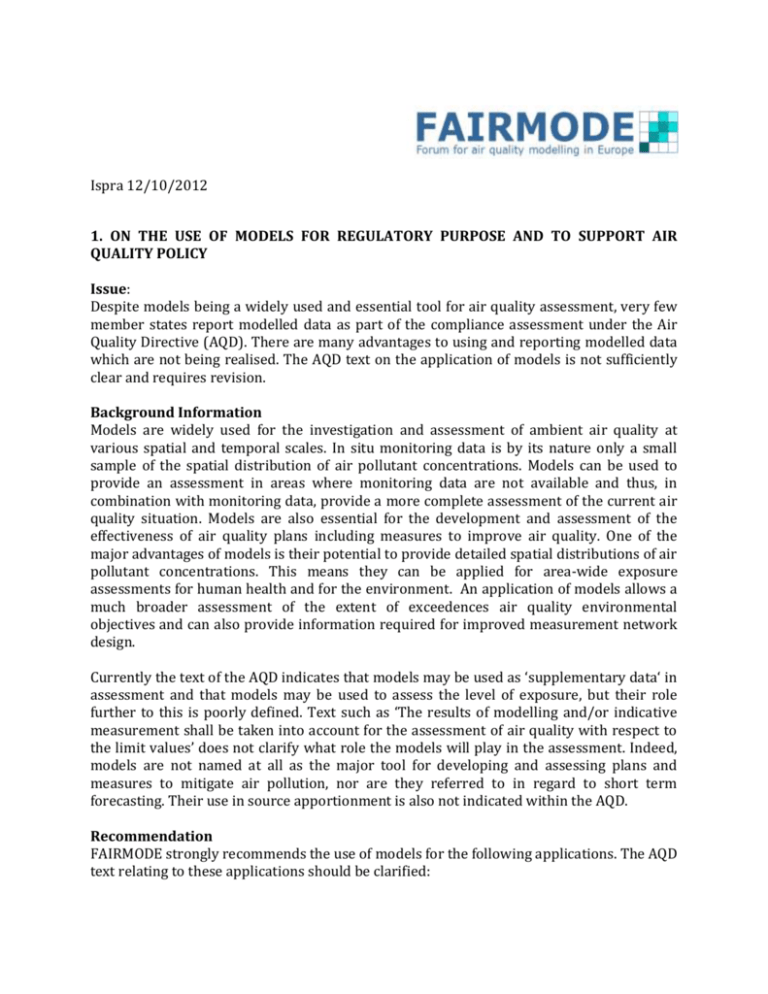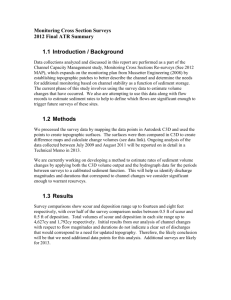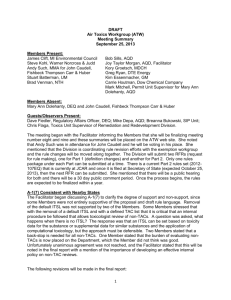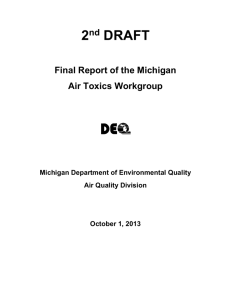- FAIRMODE
advertisement

Ispra 12/10/2012 1. ON THE USE OF MODELS FOR REGULATORY PURPOSE AND TO SUPPORT AIR QUALITY POLICY Issue: Despite models being a widely used and essential tool for air quality assessment, very few member states report modelled data as part of the compliance assessment under the Air Quality Directive (AQD). There are many advantages to using and reporting modelled data which are not being realised. The AQD text on the application of models is not sufficiently clear and requires revision. Background Information Models are widely used for the investigation and assessment of ambient air quality at various spatial and temporal scales. In situ monitoring data is by its nature only a small sample of the spatial distribution of air pollutant concentrations. Models can be used to provide an assessment in areas where monitoring data are not available and thus, in combination with monitoring data, provide a more complete assessment of the current air quality situation. Models are also essential for the development and assessment of the effectiveness of air quality plans including measures to improve air quality. One of the major advantages of models is their potential to provide detailed spatial distributions of air pollutant concentrations. This means they can be applied for area-wide exposure assessments for human health and for the environment. An application of models allows a much broader assessment of the extent of exceedences air quality environmental objectives and can also provide information required for improved measurement network design. Currently the text of the AQD indicates that models may be used as ‘supplementary data‘ in assessment and that models may be used to assess the level of exposure, but their role further to this is poorly defined. Text such as ‘The results of modelling and/or indicative measurement shall be taken into account for the assessment of air quality with respect to the limit values’ does not clarify what role the models will play in the assessment. Indeed, models are not named at all as the major tool for developing and assessing plans and measures to mitigate air pollution, nor are they referred to in regard to short term forecasting. Their use in source apportionment is also not indicated within the AQD. Recommendation FAIRMODE strongly recommends the use of models for the following applications. The AQD text relating to these applications should be clarified: 1. Assessment of air quality levels to establish the extent of exceedances and establish population exposure Forecasting air quality levels for short term mitigation and public information and warnings Source allocation to determine the origin of exceedances and to provide a knowledge basis for planning strategies Development and assessment of plans and measures to control AQ exceedances 2. 3. 4. In addition to these applications the use of models is strongly recommended for: Designing monitoring networks when models are used in combination with monitoring Determining the number of fixed monitoring sites that are required Proposed action: In all articles of the Air Quality Directives (AQD) where the four abovementioned applications are mentioned the use of models should be strongly recommended. FAIRMODE will provide a list of respective AQD and Commission Implementation Decision (CID) articles. 2. MODEL QUALITY OBJECTIVES Motivation: Data quality objective for modelling (MQO) are mentioned in the 2008 Air Quality Directive, Annex I, but the wording of the text remains ambiguous and open to interpretation. The FAIRMODE report ‘The application of models under the European Union’s Air Quality Directive – A Technical Reference Guide’ reviewed different interpretations and recommended the use of the relative directive error (RDE) indicator to provide a quantitative estimate of the model uncertainty. Despite these recommendations, the current AQD MQO retains some limitations which are inherent to their formulation. In addition the quality objectives are only valid for assessment applications, not for planning. Recommendation: FAIRMODE recommends a revision of the data quality objective for modelling Proposed action: • Fairmode is developing new data quality objectives for modelling for ambient air quality assessment, in collaboration with the Member States . This type of objectives are expected to be useful as basis to investigate MQO for the other model applications • We propose that subsequent the work of Fairmode the European Commission initiates a process for the preparation of a Guidance document on the revision of model quality objectives for assessment 3. FORUM OF EU AQ REGULATORY MODELLING Motivation: Air quality modeling in support to air quality policies in the EU context requires a constant level of communication and competence building among the various competent authorities. The organization of periodic model evaluation activities are required in order to assure harmonized practices and to guarantee comparable quality levels across Member States. Recommendation: FAIRMODE recommends that in parallel to what has already been established for the monitoring of air quality, competent authorities for modeling activities are nominated by the Member States(ref Article (3) and bullet d) quality assurance of modelling) Proposed action: Fairmode will act as coordination forum for modelling and support the competent authorities in activities that are recognised as very relevant for the for model applications listed in Recommendation #1 and that are presented here with an extended list of supporting motivations. Namely: • Model evaluation: model evaluation has to be a continuing activity. In the case of a community of models and model users joint model evaluation activities have demonstrated to be very important in speeding up the harmonization of the practices, identification and fixing of problems, rapid improvement, transition to operational activities, competence building and sharing. Fairmode can offer the right framework for testing the newly developed MQO and promoting joint model evaluation activities on common case studies. Coordinated action: model evaluation activities, competence building and sharing. • Combine use of model and monitoring data: Methodologies and techniques have been developed and tested to combine model results and monitoring data in order to provide improved assessment and predictions skills. that take in to account the experimental evidence and complement it with model results. Those developments have shown very promising results at various spatial and temporal scales. For the AQD application addressing assessments (Application 1) the most powerful tool for providing complete spatial coverage of the air quality situation, whilst still retaining the quality of fixed monitoring data, is the combined use of models and monitoring. The preamble text of the AQD refers to this: ‘Information’ from fixed measurements may be supplemented by modelling techniques and/or indicative measurements to enable point data to be interpreted in terms of geographical distribution of concentrations’. Coordinated action: inventory of ongoing activities, inter-comparison of methods, competence building, preparation of guides. • Source apportionment modeling: There is an increasing need to demonstrate whether and to what extent exceedances of limit values can be attributed to natural sources, human practices (road salting and sanding), and transboundary pollution. In the context of the preparation and implementation of air quality plans and short-term action plans, there is also a need to identify and quantify the contribution of the main pollution sources in order to efficiently design abatement measures and assess their effectiveness. Coordinated action: inventory of ongoing activities, inter-comparison and evaluation of methods, competence building, preparation of guides. • Monitoring station characterisation and meta data description for model applications and support to optimisation of monitoring and network design: The location, characterization and representativeness of a measurement station in a monitoring network is of fundamental relevance for the evaluation of model results (see point 3.) and when using network output as model input data. It is well recognized that current station classification and characterization is not harmonized across the EU with some consequences for data interpretation and use. Coordinated action: inventory of ongoing activities, competence building, preparation of guides. 4. QUALITY ASSURANCE AND CONSISTENCY OF EMISSION INVENTORIES Motivation: Air quality emissions inventories (EIs) have been compiled at European level for regulatory purposes and also to support air quality modelling applications for the assessment and improvement of air quality. Emission information is essential in support for AQ planning under the AQ directive because it provides the link between responsible emission sources, their relative shares and abatement potentials. Current emission inventories are constructed at different scales (regional, national, city/urban) but these EIs are often not consistent and may cause discrepancies in impact assessments at the different scales. The present compilation methods do not always allow relating emission sources with their abatement potential. More detailed emission inventory compilation methods and better systems for QA/QC of emission information need to be implemented to support AQ planning and account for the identified discrepancies in the different scales. Recommendation: FAIRMODE recommends to investigate and improve the compilation, consistency and quality assurance of emissions data suitable for AQ modeling under the directive Proposed action: • Emissions are not mentioned in the AQD and the need to work to increase the quality of emission inputs needs to be introduced in the revised text. • Promote guidance initiatives for the compilations of emission data for AQ models under the directive • Support competence building initiatives to secure the consistency of detailed bottom-up emission inventories with those compiled for regulatory purposes at local, national and European scale










